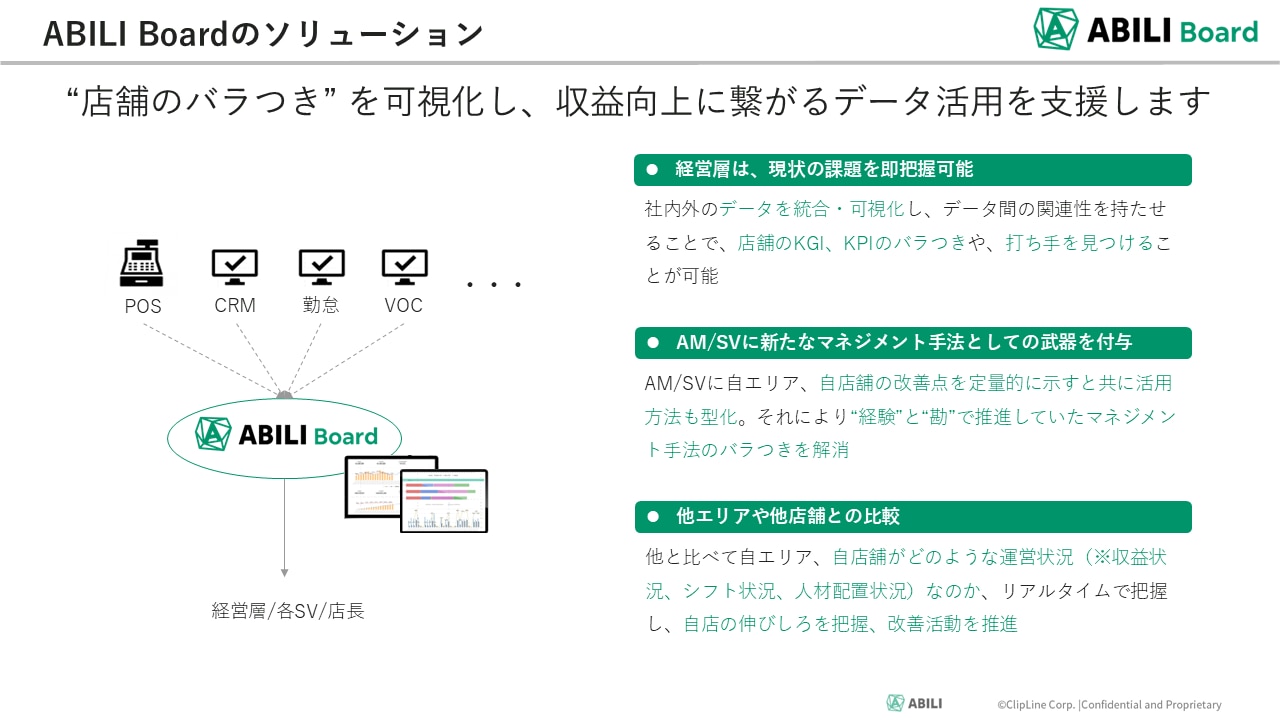
付加価値を高める DX のカギ
サービス業のテック活用は
「パッチワーク」ではなく「チェーン」で考える
このレポートは2024年11月26日に開催した主催イベント「ABILI Special Seminar」でのClipLine株式会社 取締役COO 金海 憲男による基調講演、
「"サービステック"と変革支援で実現する、持続的成長を実現する本部と現場のあり方」の内容をまとめたものです。
働き手の減少と市場の縮小に直面しているサービス業。生き残るためには、これまで以上に高付加価値なサービスを生み出す必要がありながら、それを担う人材の採用や定着は厳しさを増しており、デジタルの活用は急務といえる。
そんな中、デジタル活用はいかにするべきか。多くの会社が DX に取り組みつつも“画餅”に終始してしまう状況を打破するポイントは何か。そのヒントとして、「人口減少時代、今こそ問い直す“サービス”とテクノロジーのあり方〜多店舗サービス業の未来と競争戦略」から、同社の取締役 COO である金海憲男によるセッションのレポートをお届けする。
多店舗・多拠点サービスが抱える難しさと構造課題
「人口減の時代において、店舗ビジネスをいかに成長させるか」「人口減対策として取り組んだはずの DX が、なぜ成果につながらないのか。そして、どうすべきか」をテーマにした本セッション。冒頭では、まず製造業と比較しながらサービス業の難しさが示された。
例えば、製造業では商品に形があり、目視できる。それに対し、サービス業は接客などの役務が目に見えず、形がない「無形性」が特徴である。加えて、生産する際に検品があり、基準を満たしたものだけが商品となるが、サービス業は「同時性」という特徴もあり、生産と消費が同時である。前もって顧客対応を保存しておくことなどはできない。
その他、サービス業は「消滅性」も帯びている。消滅性とは、その場で消費されてしまい、残らないこと。製造業の商品が、生産した後に在庫として保管されるのと好対照だ。加えて、同一商品は同じ基準、同じラインで生産されるのに対し、サービス業では拠点やスタッフによって、応対品質のバラつきが生じがちであり「異質性」もある。こうした「無形性」「同時性」「消滅性」「異質性」から、サービス業は「バラつき」が生じがちとなり、教育やマネジメントの難易度が高いとされる。
「モノづくりの世界であれば、同じクルマなのに、燃費が異なったり、ヘッドライトの形が違ったりすることはありません。しかし、サービス業では『注文したら、メニューとは全然違う商品が提供された』『スタッフによって、いっていることが違う』といったバラつきが当たり前に生じているのです」(金海)
バラつきを解消しようにも、今度は組織のピラミッド構造による「情報伝達の伝言ゲーム化」や、エリアマネジャー・スーパーバイザーといったミドルマネジメント層に情報が集中してしまう「砂時計化」といった問題が立ちはだかる。
組織は大きくなるほど、階層が増えて情報の伝達に時間がかかるようになる。そして、経営層から現場に伝わるまでに、誰か 1 人でも理解しきれていなかったり、説明が下手だったりするだけで、正しく伝わらない。また、トップから現場へ、あるいは現場からトップへの情報がハブであるミドルマネジメント層に集中し、負担が高まりすぎて的確なタイミングや適切な内容で情報が行き渡らなくなってしまう。

人口減はこれからが「本番」 デジタルで付加価値を強化できるかがカギ
このような課題を抱えるサービス業、特に店舗ビジネスはどのように成長させるべきなのだろうか。まず大前提として理解すべきは、人口減のピークがこれから来ることだ。総務省や国立社会保険・人口問題の統計によると、2010〜2020 年で減少した人口は 235 万人だった一方、2020〜2030 年では 3 倍近くとなる 658 万人の減少が見込まれる。
また、人口減少は働き手不足に焦点が当たることも多いが、同時に顧客が減ることも意味する。起こるのが、国内市場の縮小だ。より高付加価値なビジネスへと転換する必要がありつつも、反比例のように人員確保は難しい。このように「目指す姿」と「現実」のギャップが、時間とともにワニの口のように開いていく。
そんな状況で頼るべきが「デジタル」なのはいうまでもない。ただ、活用方法には注意が必要だ。
「現状、多くの企業におけるデジタル活用といえば『人の仕事の置き換え』にとどまっています。セルフレジなどが好例ですね。確かに効率化も重要ですが、それだけでなく、『人の仕事の付加価値を強化する』。つまり、現在できていないことを実現するような活用も必要です」
DX を「パッチワーク」にせず、サービスプロフィットチェーンで有機的に考える
現状の仕事をデジタルに置き換えるのではなく、付加価値を生み出す DX で重要なのは「それぞれの施策を可視化し、いかに方向付けできるか」だと金海は話す。
「DX でお困りの声としてよくあるのが『人的資本経営を目的に、タレントマネジメントや e ラーニングのツールを入れたが、効果が分からない』『業務支援ツールを導入したのに、現場が使っていない』といった声です。これらは、全体の流れを考えず個別最適で導入する、いわばパッチワークのような取り組みになっているのが原因といえます」
上述したような、人間の付加価値を強化するというお題目を考えると、サービス業における DX の目的は「顧客体験価値のデジタル化」にあるといえる。そして、そのためには業務プロセスの効率化が必要であり、さらにその前提としては学習や教育のデジタル化もあるべきだ。これらの取り組みが結び付いてこそ、初めて DX は成功といえる。
「社内サービスの質が上がれば、従業員体験が向上します。それがサービス品質の向上となり、顧客満足の上昇、ひいては業績に貢献する——これは、サービスプロフィットチェーンと呼ばれる考え方であり、特にサービス業では重要なモデルといえるでしょう」
こうしたサービスプロフィットチェーン全体のデータ化や分析、さらにはベストプラクティスの共有などを通してサービス業の業績アップに貢献するツール群が、ClipLine の提供する「ABILI」だ。
例えば「ABILI Board」であれば、サービスプロフィットチェーン全体をデータ化し、分析するダッシュボードとして活用できる。売り上げが下がったときに、客数が影響しているのか、はたまた客単価が悪化しているのか。客数が影響しているのであれば、新規客とリピーター、どちらの変動があったのか——このように現状からドリルダウンする形で課題の抽出ができる。
「サービスプロフィットチェーンの分析は、これまでエリアマネジャーなどが勘と経験で行っていました。ABILI Board によってこれをデータとロジックに置き換えることで、現場に行かずとも状況を把握でき、多拠点マネジメントの負担を軽減します」

”山登り”にはパートナー選びも重要
サービスプロフィットチェーンの可視化や分析に効くのが ABILI Board だとすれば、上述したような「伝言ゲーム化」や「砂時計化」の解消に役立つのが、ABILI Clip だ。
「ABILI Clip は、動画を活用して本部と現場の情報伝達をスムーズにするだけでなく、拠点間のベストプラクティス共有にも活用できるソリューションです。本部と現場を直接つなげることは、経営メッセージなどのストレートに伝えたい情報の伝言ゲーム化を防ぐだけでなく、ミドルマネジメント層の負担軽減にも寄与します。その他、販促や接客が上手な拠点のノウハウを動画にして、ベストプラクティスの横展開にも効果を発揮します」
ClipLine 株式会社ではこの他にも ABILI として、働き手のスキルを可視化し、キャリアアップや評価プロセスのデジタル化を可能にする「ABILI Career」、顧客アンケートを簡単かつリアルタイムに実現できる「ABILI Voice」、それぞれの運用支援やコンテンツ制作をサポートする「ABILI Partner」を用意している。
さらに子会社として、伴走型の支援で組織戦略と実行を担い、これまでに 200 以上のプロジェクトで 1500 億円以上の業績向上実績を持つ「Chain Consulting 株式会社」もあり、組織が一気に改革を進めるパートナーとして多角的な支援を行っている。
「業務支援を行う SaaS が ABILI だとすれば、Chain Consulting は事業の伸びしろの分析、改善策や投資すべき項目の洗い出しから実行支援までを伴走するコンサルティングファームです。DXを中心に、企業変革は山登りのように目的地までのロードマップを引き、地道かつ大胆に取り組む必要があります。皆様の課題と目的に合わせ、ぜひそのための”シェルパ”や”コンパス”として、われわれを頼っていただければと思います」



